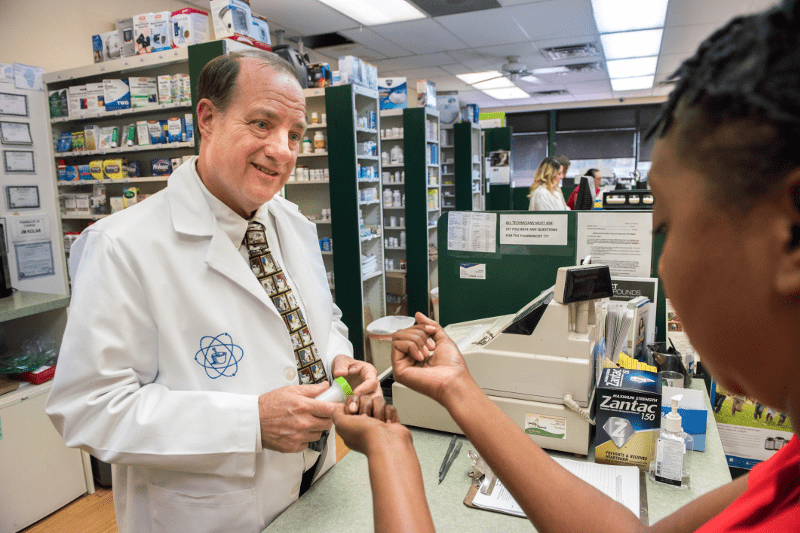4 Ways to Prevent Human Error in Community Pharmacy

A side effect of being human is that, on occasion, we make mistakes. Another byproduct? We strive to limit our errors. That’s why you clicked on this article in the first place, right?
During a nationwide survey of community pharmacists, 53% of respondents admitted to making drug errors in the prior 60-day period.
- Drug Topics survey
Let’s face it: medication errors are a widespread problem, and in the worst cases they can cause harm to patients. There are many errors one can make in a pharmacy, including data entry, drug, dose, dosage form, labeling or even mistakes related to medication directions. These errors are often exacerbated due to age-old systems and processes.
How can we work toward reducing the number of mistakes we commit? Here are four ways to prevent human error in community pharmacy.
1. Organize your pharmacy workspace
“Keeping your pharmacy organized isn’t about perfection, it’s about efficiency. When you know where everything is, it’s far more difficult to make messy errors like grabbing the wrong drug, or putting a vial in the wrong basket.”
- Nicole Bernabe, CPhT
Organization is critical to preventing errors in your community pharmacy — and every aspect of life, for that matter. Implementing a well thought-out workflow is often times the most effective tactic when it comes to reducing errors in the pharmacy. You will want to make sure that your workspace, environment and prescription filling workflow is arranged in a manner that reduces potential distractions. A decluttered area allows for a standardized routine which helps technicians and pharmacists focus on each individual prescription. Simple standardization tactics like affixing the label to the patient’s prescription bottle before moving on to the next prescription can also help prevent dispensing errors.
Additionally, organizing your workflow and pharmacy space can help prevent transcription errors while entering prescriptions or patient information into your pharmacy management system.
2. Implement a telepharmacy workflow
A telepharmacy workflow helps prevent errors in the pharmacy by removing error-prone processes and visually capturing every step of the prescription-filling process. In a community telepharmacy, pharmacy technicians capture images which, along with the patient’s profile, are securely stored and sent to the remote pharmacist for review.
Capturing and storing an image of every prescription dispensed at the pharmacy ensures that you have a solid audit log (or audit defense). Image-capture technology enables pharmacists to look through records and identify exactly where, if at all, an error was made. A modern telepharmacy workflow puts information in front of multiple sets of eyes (pharmacy employees), helping to prevent human errors before they reach the patient. Using a queue-based workflow allows the pharmacist to adequately review and verify prescriptions when they are able to focus on the patient at hand.
“You can’t hide anything from the OutcomesOne platform. It’s that precise.”
- LaDonna Poehler, pharmacist, owner of Medicine Shope #1339 and Poehler’s Pharmacy
3. Automated pill-counting machines
Whether it’s from distractions and having to start over again or simple counting mistakes, hand-counting errors happen all too often in the pharmacy — even when counting by five. Automation has come a long way, and using an automated pill-counting machine can help reduce human error, save money and amplify effectiveness. Tablet-counting technology helps pharmacy technicians maintain a safety-first mindset while establishing efficiencies and streamlining workflow. These small, fast and accurate machines provide more benefits than outdated scales and cumbersome tray-and-spatula methods. The pharmacy is a busy place and using an automated tablet counter can help organizations strike the perfect balance of safety and efficiency.
4. Always provide thorough patient counseling
When we talk about reducing human errors in the pharmacy, we also need to discuss how to reduce patient error. It’s important we take counseling a step further and provide it for each patient instead of giving them an open-ended offer. For example, having the patient view the actual drug presents them an opportunity to ask questions in case it looks different than normal. In addition, any pharmacy errors are can be prevented by ensuring the patients have enough knowledge and understanding to safely take their prescribed medications. One way to also help ensure patient understanding and knowledge is to ask open-ended questions: for example, instead of asking, “Do you have any questions?”, ask, “What questions do you have about your medication?” Counseling offers pharmacists a final checkpoint to ensure the patient has everything necessary to stick to their medication regimen.
There are many ways we can prevent errors from occurring in community pharmacies. That begs the question: what are you currently doing to prevent human error in your pharmacy? Comment below and let us know!
Looking for related reading materials? Read: 3 Tips to Improve Your Community Pharmacy Workflow.





